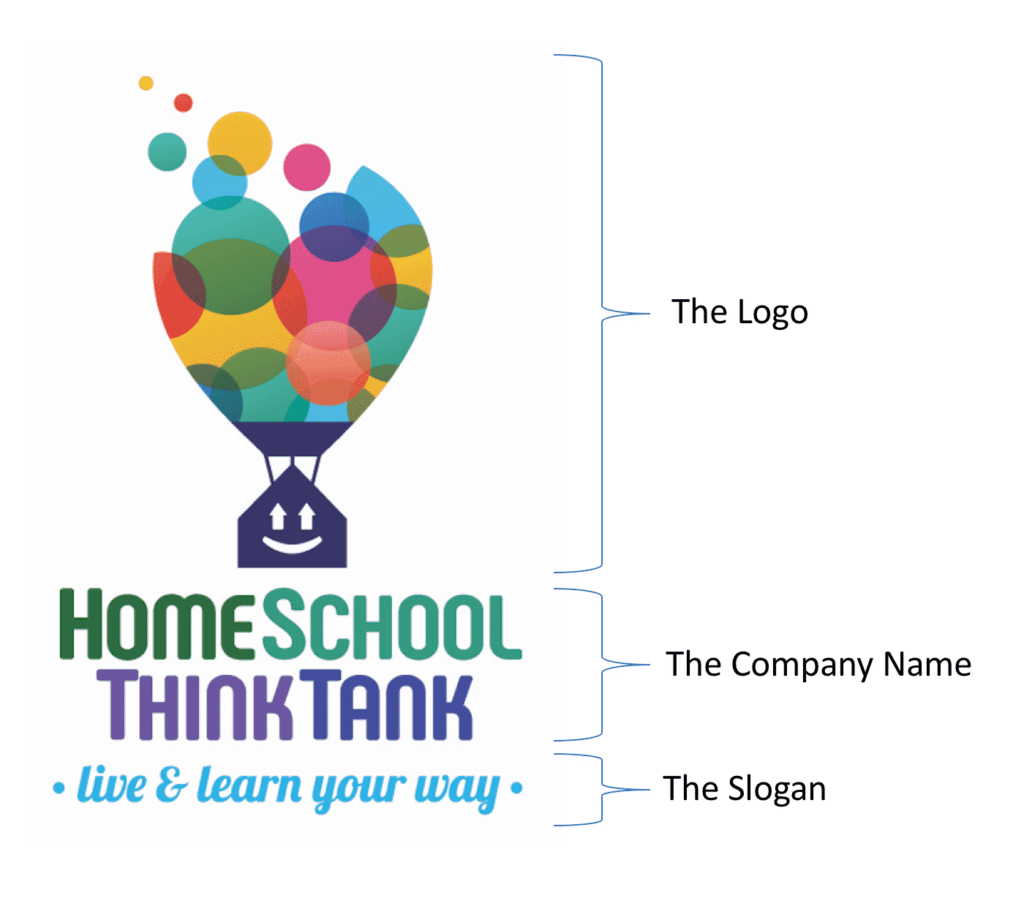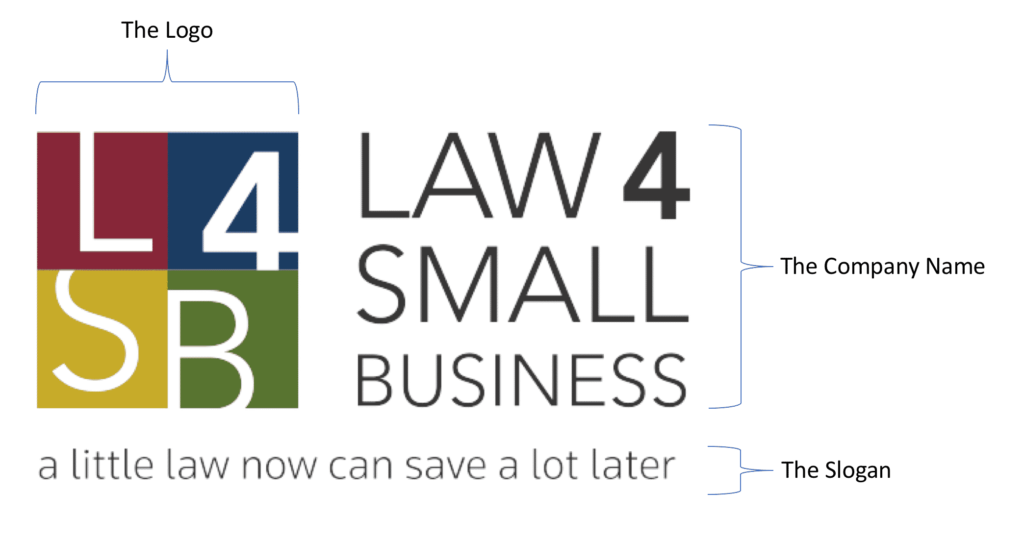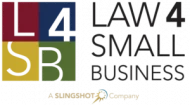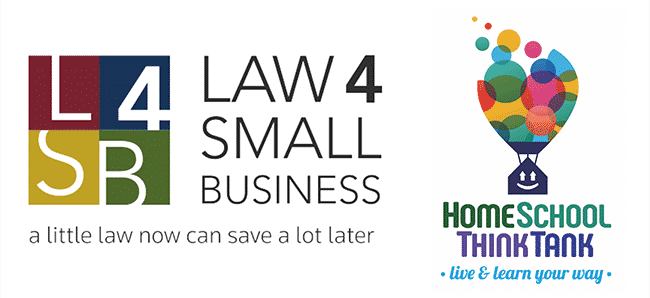Special Thanks: I want to thank Jackie Wheeler of HomeSchool ThinkTank, a client of L4SB, for letting me use her trademark as the example for registering a trademark in this article. There is a small bio and description of Jackie and her company, as well as the designer who created the logo for Jackie’s company, at the end of this article.
What Elements of a Trademark Should be Trademarked?
Look at the two trademarks above. The first is our company, Law 4 Small Business. The other is from HomeSchool ThinkTank. These trademarks, like many trademarks for small business, are compromised of at least three major elements: Some graphical or stylized element representing “the logo,” the name of the company, and a tagline or slogan, all important things to consider when registering a trademark.
The question is, what do you register for a trademark?
- The logo itself?
- The name of the company?
- The slogan or tagline?
- The entire thing, or maybe without the slogan or tagline?

You would be surprised how many people will register the entire thing, and then get upset later when they cannot prevent someone else from using their company name in the same industry, despite having a valid US trademark for their overall trademark.

Both examples of the trademarks consist of the graphical or stylized element, the literal word for the company name, and a tagline or slogan. Not all trademarks need to follow this pattern, and indeed many trademarks do not (i.e. where the name of the company is graphically represented in the design element of the logo).
It’s a Balancing Act Between Cost, Availability of the Mark and Breadth of Coverage
The question you need to ask yourself when registering a trademark is, what specific element(s) do you consider “unique” and want to prevent others from potentially using, duplicating or creating a “likelihood of confusion?”
Do you want to prevent anyone from using any portion of your trademark? If so, then paradoxically, registering the entire thing will not protect all the elements individually. Registering the entire trademark will only prevent someone else from creating a likelihood of confusion for the entire mark, not specific elements within the mark. To learn more about “likelihood of confusion, read our article entitled, Likelihood of Confusion — Don’t Be Confused by Trademark Law.
Therefore, if you want to prevent others from using any specific element of your trademark, then it’s critical that you register those specific elements of your trademark that you want protection. If you don’t care, and only want to prevent someone from using the entire thing, then registering the entire thing is appropriate.
Unfortunately the US Patent and Trademark Office (USPTO) charges for each trademark registration, and registering each element separately represents a separate trademark registration and cost.
Breadth versus Registrability in Registering a Trademark
A “word mark” is considered the strongest form of trademark protection you can obtain. Read more about this in a blog article I previously wrote, entitled Standard Character Marks vs Stylized Logos. The problem is, there can be many reasons you’re unable to obtain a word mark for the name of product or service, including:
- The name is descriptive
- The name is a surname (read more about this)
- The name is geographically misdescriptive
- The name is geographically descriptive (a subset of descriptive)
- The name is common or creates a likelihood of confusion with another trademark
When confronted with a problem registering a word mark, a design mark can be a good fallback option to at least protect the logo or other important aspects of the mark.
In the world of trademark law, the general rule is to seek registration of the simplest form of your mark that will pass muster and be approved. This means, cut out the slogan or tagline. Register the logo alone, and create a separate registration with the logo and name. Register a black-and-white logo, not color.
Some Additional Comments About Trademark Law
Remember that when registering a trademark, you will need to renew your trademark in five (5) years. To do this, you must use your trademark in commerce for those five (5) years consistently, without modification. This has some practical implications you should consider now, while thinking about trademark registration.
- First, what are the odds you may want to change your tagline or slogan down the road? If such a thing is included in your trademark, you better NEVER change it otherwise you could lose your trademark.
- Second, what are the odds you may want to change your logo down the road? Same issue. If you change your logo, and that logo is a part of your trademark, you could lose your trademark when it comes time to renew it.
- Third, love your slogan and want to register it as a trademark? Remember that you can only trademark “source identifiers” for goods or services. Are you using your slogan, by itself, as a “source identifier?” If not, your trademark application (for the slogan alone) will not get approved.
- Fourth, are there many elements to your logo and do you want to use different forms or flavors of your logo? Avoid it. It’s important to use your logo consistently and continuously. You can surely use components of your logo to accent your brand (i.e. taking elements to use as bullets in paragraphs, watermarking pages and more), but don’t inconsistently use your trademark for source-identification. This must be consistent.
- Fifth and finally, is color really important? I know you think it is, but would you be upset if someone had a similar logo, but using different colors? If so, then you want to register a black-and-white logo, without claim to any specific color.
My General Advice for Registering a Trademark Given this Article?
Given the above, my advice to HomeSchool ThinkTank is as follows:
- Register a Word Mark for HOMESCHOOL THINKTANK
- Register a Design Mark for the BLACK AND WHITE version of the LOGO only, WITHOUT the company name; Unless they intend to NEVER use the LOGO without the company name, then they can register with the company name
- Do not register the Design Mark with the slogan
- Don’t bother registering the Slogan as a Word Mark or Design Mark, unless the slogan will be used by itself, as a source identifier
- Finally, don’t use other iterations of the Design Mark as a source identifier — be consistent
Law 4 Small Business, P.C. (L4SB). A little law now can save a lot later. A Slingshot company.
This article was made possible by HomeSchool ThinkTank, a L4SB client.
Hi, my name is Jackie Wheeler, a long-time homeschooling mother of two. I’ve started my business, HomeSchool ThinkTank™, to serve homeschool families and others who support homeschoolers. We educate, motivate, and provide resources to the homeschool community. This business started by writing a book. In the beginning, I was trying to learn the ins & outs of publishing and marketing, so I could help my daughter publish a book. Now, I have found that I enjoy writing as well. In addition, I am finding tremendous satisfaction as I learn how to build a brand and a business. Creating the logo for my business has been a key part of branding. When you see the logo my graphic designer created, you’ll see how we are a team. I gave Monica so many examples of what I like in color, pattern, font, and more. Monica read my business plan, listened, and embraced my vision. She is helping bring my dream to life. HomeSchool ThinkTank™ will serve and collaborate with both homeschool families and homeschool providers. We will elevate the homeschool community in every way we can. This dream will extend well beyond my own children and community, this dream is to be shared with the world. Hop on over to visit Jackie Wheeler & HomeSchool ThinkTank™ at www.homeschoolthinktank.com.
The logo and design for the HomeSchool ThinkTank was produced by Monica Woodward with iDesign.
Hi! My name is Monica Woodward. I am a freelance/contract graphic designer in the Greater Chicago area – recently just moved here from Scottsdale, Arizona after 23 years. I have over 18 years of experience with extensive knowledge in both design and print. My experience ranges from identity creation and branding to project management and print coordination. My objective is to deliver top-notch graphic design tailored to each project, focusing on client’s needs in order to achieve their goals. Branding small businesses is my specialty and passion! My skills include branding, print advertising, direct mail, logo and identity development, brochures, catalogs, packaging, trade show displays, large format indoor/outdoor signage, website design and email marketing. I’ve worked with companies of all shapes and sizes so contact me if you would like to work together to make your business come alive! I can be reached at 480-330-7784, [email protected] and at linkedin.com/in/monicawoodward.


2 Comments
Excellent article in terms of simplicity of complex issues. That said, you might want to fix this: “In the world of trademark law, the general rule is to seek registration of the most simplest form of your mark that will pass muster and be approved. This means, cut out the slogan or tagline.” I’m sure most simplest was a typographical oversight or something of that nature. Thanks for the article.
Yikes! That’s what I get for writing some of these articles late at night.
Thank you for the feedback!
Larry.